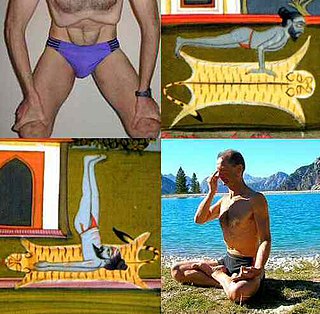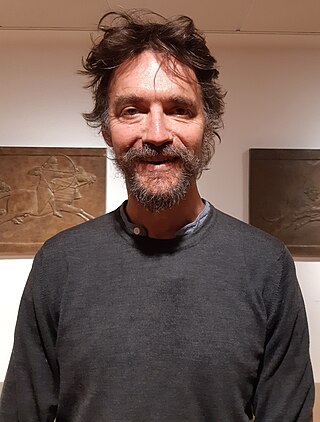
Kundalini yoga derives from kundalini, defined in tantra as energy that lies within the body, frequently at the navel or the base of the spine. In normative tantric systems, kundalini is considered to be dormant until it is activated and channeled upward through the central channel in a process of spiritual perfection. Other schools, such as Kashmir Shaivism, teach that there are multiple kundalini energies in different parts of the body which are active and do not require awakening. Kundalini is believed by adherents to be power associated with the divine feminine, Shakti. Kundalini yoga as a school of yoga is influenced by Shaktism and Tantra schools of Hinduism. It derives its name through a focus on awakening kundalini energy through regular practice of mantra, tantra, yantra, yoga, laya, haṭha, meditation, or even spontaneously (sahaja).

Hatha yoga is a branch of yoga that uses physical techniques to try to preserve and channel vital force or energy. The Sanskrit word हठ haṭha literally means "force", alluding to a system of physical techniques. Some hatha yoga style techniques can be traced back at least to the 1st-century CE, in texts such as the Hindu Sanskrit epics and Buddhism's Pali canon. The oldest dated text so far found to describe hatha yoga, the 11th-century Amṛtasiddhi, comes from a tantric Buddhist milieu. The oldest texts to use the terminology of hatha are also Vajrayana Buddhist. Hindu hatha yoga texts appear from the 11th century onward.
In Sanskrit texts, Rāja yoga was both the goal of yoga and a method to attain it. The term also became a modern name for the practice of yoga in the 19th-century when Swami Vivekananda gave his interpretation of the Yoga Sutras of Patanjali in his book Raja Yoga. Since then, Rāja yoga has variously been called aṣṭāṅga yoga, royal yoga, royal union, sahaja marg, and classical yoga.

Pranayama is the yogic practice of focusing on breath. In yoga, breath is associated with prana, thus, pranayama is a means to elevate the prana-shakti, or life energies. Pranayama is described in Hindu texts such as the Bhagavad Gita and the Yoga Sutras of Patanjali. Later in Hatha yoga texts, it meant the complete suspension of breathing. The pranayama practices in modern yoga as exercise are unlike those of the Hatha yoga tradition.

Yoga nidra or yogic sleep in modern usage is a state of consciousness between waking and sleeping, typically induced by a guided meditation.

The Haṭha Yoga Pradīpikā is a classic fifteenth-century Sanskrit manual on haṭha yoga, written by Svātmārāma, who connects the teaching's lineage to Matsyendranath of the Nathas. It is among the most influential surviving texts on haṭha yoga, being one of the three classic texts alongside the Gheranda Samhita and the Shiva Samhita.

Satyananda Saraswati, was a Sanyasi, yoga teacher and guru in both his native India and the West. He was a student of Sivananda Saraswati, the founder of the Divine Life Society, and founded the Bihar School of Yoga in 1964. He wrote over 80 books, including the popular 1969 manual Asana Pranayama Mudra Bandha.
Shiva Samhita is a Sanskrit text on yoga, written by an unknown author. The text is addressed by the Hindu ascetic Shiva to his consort Parvati. The text consists of five chapters, with the first chapter a treatise that summarizes nondual Vedanta philosophy with influences from the Sri Vidya school of South India. The remaining chapters discuss yoga, the importance of a guru (teacher) to a student, various asanas, mudras and siddhis (powers) attainable with yoga and tantra.

Sir James Mallinson, 5th Baronet, of Walthamstow is a British Indologist, writer and translator. He is recognised as one of the world's leading experts on the history of medieval Hatha yoga.

Yoganidrasana, or Yogic Sleep Pose is a reclining forward-bending asana in modern yoga as exercise. It is sometimes called Supta Garbhasana. The name Dvi Pada Sirsasana is given to the balancing form of the pose.
Modern yoga is a wide range of yoga practices with differing purposes, encompassing in its various forms yoga philosophy derived from the Vedas, physical postures derived from Hatha yoga, devotional and tantra-based practices, and Hindu nation-building approaches.
The Amṛtasiddhi, written in a Buddhist environment in about the 11th century, is the earliest substantial text on what became haṭha yoga, though it does not mention the term. The work describes the role of bindu in the yogic body, and how to control it using the Mahamudra so as to achieve immortality (Amṛta). The implied model is that bindu is constantly lost from its store in the head, leading to death, but that it can be preserved by means of yogic practices. The text has Buddhist features, and makes use of metaphors from alchemy.
Mark Singleton is a scholar and practitioner of yoga. He studied yoga intensively in India, and became a qualified yoga teacher, until returning to England to study divinity and research the origins of modern postural yoga. His doctoral dissertation, which argued that posture-based forms of yoga represent a radical break from haṭha yoga tradition, with different goals, and an unprecedented emphasis on āsanas, was later published in book form as the widely-read Yoga Body.
The Amaraugha Prabodha is a 12th-century Sanskrit text on hatha yoga, attributed to Gorakshanath. Its close connection with a Vajrayana text, the Amritasiddhi, implies a Buddhist origin for the practice of hatha yoga.
The Dattātreyayogaśāstra, a Vaisnava text probably composed in the 13th century CE, is the earliest text which provides a systematized form of Haṭha yoga under that name, and the earliest to place its yoga techniques under the name Haṭha.
The Yogabīja is an early Haṭha yoga text, from around the 14th century. It was the first text to propose the derivation of haṭha from the Sanskrit words for sun and moon, with multiple esoteric interpretations.

The Yogacintamani is an early 17th-century hatha yoga text, covering the eight auxiliaries of yoga. The asana section in all the manuscripts describes 34 asanas, while variations in some manuscripts add another 84, mentioning most of the non-standing asanas used in modern postural yoga.

Yoga in France is the practice of yoga, whether for exercise or other reasons, in France. The relaxation technique of yoga nidra was pioneered by Dennis Boyes, whose 1973 book preceded Satyananda Saraswati's popularisation of the technique.
The Yogatārāvalī is a short yoga text of 29 verses from the 13th or 14th century, covering both haṭha yoga and rāja yoga. It mentions the yogic sleep state of samadhi or yoganidra. The text was used by the author of the 15th century Haṭhapradīpikā. The Yogatārāvalī's first verse is chanted by Ashtanga vinyasa yoga students, following Pattabhi Jois's practice, at the start of each class. The text leads up to the teaching that yoga brings "complete transcendence of the world and mind", uninterested in gaining siddhis (powers).

Yoga is by origin an ancient spiritual practice from India. In the form of yoga as exercise, using postures (asanas) derived from medieval Haṭha yoga, it has become a widespread fitness practice across the western world. Yoga as exercise, along with the use that some make of symbols such as Om ॐ, has been described as cultural appropriation.












